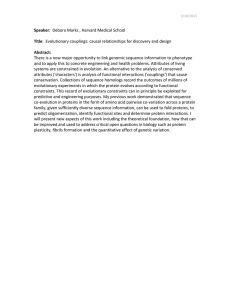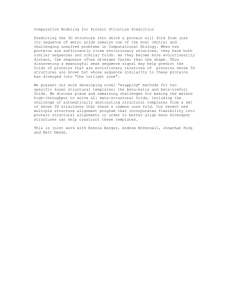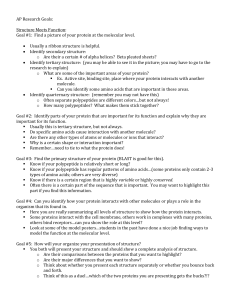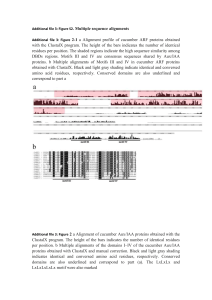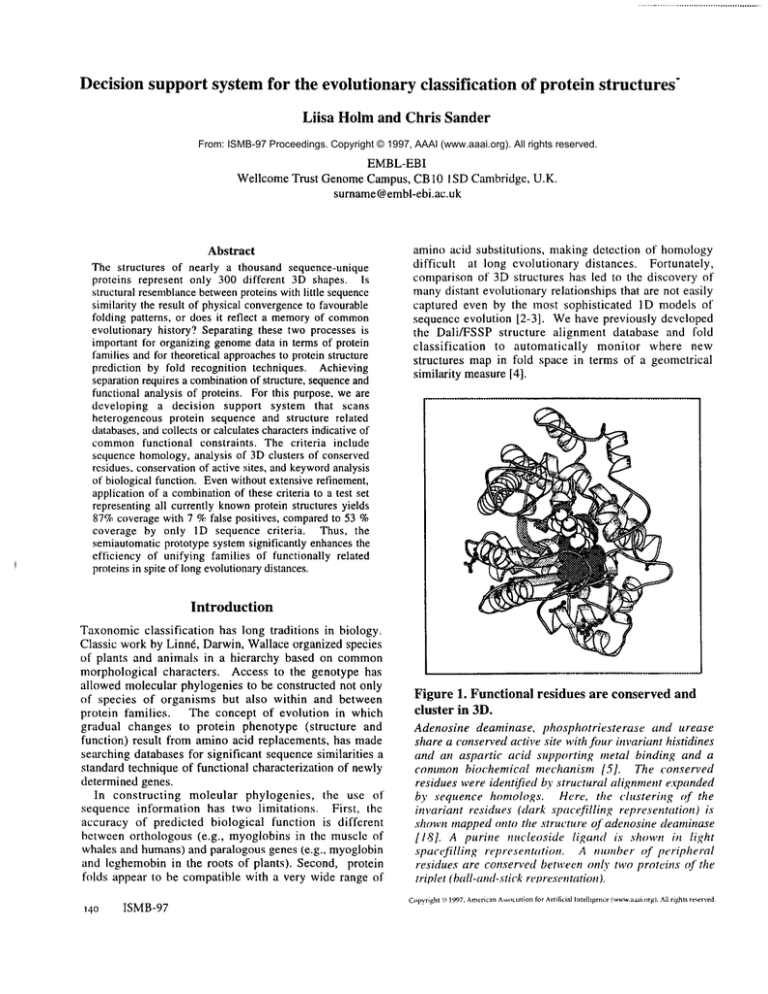
Decision support system for the evolutionary classification
of protein structures"
Liisa Holmand Chris Sander
From: ISMB-97 Proceedings. Copyright © 1997, AAAI (www.aaai.org). All rights reserved.
EMBL-EBI
Wellcome Trust Genome Campus, CB 10 I SD Cambridge, U.K.
surname @embl-ebi.ac.uk
Abstract
The structures of nearly a thousand sequence-unique
proteins represent only 300 different 3D shapes, ls
structural resemblancebetweenproteins with little sequence
similarity the result of physical convergenceto favourable
folding patterns, or does it reflect a memoryof common
evolutionary history? Separating these two processes is
important for organizing genomedata in terms of protein
families and for theoretical approachesto protein structure
prediction by fold recognition techniques. Achieving
separation requires a combinationof structure, sequenceand
functional analysis of proteins. For this purpose, we are
developing a decision support system that scans
heterogeneous protein sequence and structure related
databases, and collects or calculates characters indicative of
commonfunctional constraints.
The criteria include
sequence homology, analysis of 3D clusters of conserved
residues, conservation of active sites, and keywordanalysis
of biological function. Even without extensive refinement,
application of a combinationof these criteria to a test set
representing all currently knownprotein structures yields
87%coverage with 7 % false positives, comparedto 53 %
coverage by only 1D sequence criteria.
Thus, the
semiautomatic prototype system significantly enhances the
efficiency of unifying families of functionally related
proteins in spite of long evolutionarydistances.
amino acid substitutions,
making detection of homology
difficult
at long ew)lutionary distances. Fortunately,
comparison of 3D structures has led to the discovery of
manydistant evolutionary relationships that are not easily
captured even by the most sophisticated
ID models of
sequence evolution [2-3]. We have previously developed
the Dali/FSSP structure
alignment database and fold
classification
to automatically
monitor where new
structures map in fold space in terms of a geometrical
similarity measure [4].
Introduction
Taxonomic classification
has long traditions in biology.
Classic work by Linnd, Darwin, Wallace organized species
of plants and animals in a hierarchy based on common
morphological characters.
Access to the genotype has
allowed molecular phylogenies to be constructed not only
of species of organisms but also within and between
protein families.
The concept of evolution in which
gradual changes to protein phenotype (structure
and
function) result from amino acid replacements, has made
searching databases for significant sequence similarities a
standard technique of functional characterization of newly
determined genes.
In constructing
moleular phylogenies,
the use of
sequence information has two limitations.
First, the
accuracy of predicted biological function is different
between orthologous (e.g., myoglobins in the muscle of
whales and humans) and paralogous genes (e.g., myoglobin
and leghemobin in the roots of plants). Second, protein
folds appear to be compatible with a very wide range of
Figure 1. Functional
cluster in 3D.
residues
are conserved and
Adenosine deaminase, phosphotriesterase
and urease
share a conserved active site with four invariant histidines
and an aspartic acid supporting metal binding and a
common biochemical
mechanism [5]. The conserved
residues were identified by structural alignment expanded
by sequence homologs. Here, tire clustering
of the
invariant residues (dark spaeefilling representation)
shown mapped onto tire structure of adenosine deaminase
[18]. A purine nucleoside
ligand is shown in light
spacefilling
representation.
A number of peripheral
residues are conserved between only two proteins of the
triplet (ball-and-stick ret~resentation ).
Copyright~) 1997, AmericanA~oclationfor Artificial Intelhgence (w~.aaai.orgl. All rights reserved.
~4o
ISMB-97
Figure 1 illustrates one case of remote evolutionary
relatives discovered by structure comparison. Urease,
phosphotriesterase and adenosine deaminasenot only have
a conserved structural core but support a conserved active
site constrained to perform metal-assisted hydrolysis of
amide bonds. The active site is madeup of four histidines
and an aspartie acid; these are the only residues whichare
invariantly conserved in all three families. Althoughthe
active site residues are widely dispersed along the
polypeptide chain, they cluster together in the folded
structure. They are invariantly conserved between the
respective protein families, defining a sharp sequence
signature for the superfamily that led to the evolutionary
unification of a large set of distinct amidohydrolase
families [5].
Here, we examine computational criteria for verifying
hypotheses of functional homologybetween proteins with
very low sequence similarity. Computationally, we work
in a decision support system framework, using intelligent
agents to access heterogeneous databases (Figure 2).
calibrate the selectivity and sensitivity of quantitative
criteria related to biological function against a balanced,
comprehensive test set. Wediscuss the potential of a
composite criterion as the basis for an automatic expert
system, assisting or replacing humanexperts [6-7], that
tackles the problem of evolutionary classification of
protein structures based on more than mere sequence and
structure criteria.
Test set
The notion of a biologically significant relationship
betweenproteins is intuitive and therefore rather imprecise.
In this work, we formulate a numberof quantitative criteria
and test howwell they correspond to humanintuition. The
test set was composedof 458 evolutionarily unrelated and
482 related pairs (classified manually by L.H.). The test
set is available electronically over the Internet at the URL
http://www2.embl-ebi.ac.uk/dali/testset.
Our basic assumptionin constructing a test set was that
remote homologsare detected in structure comparison and
are positioned in structure space as near neighbours. The
test set consisted of 941 proteins which have known3D
structures and less than 25 %mutual sequence identity. In
order to obtain a balanced sample of pairs in terms of fold
types and protein families, a minimal spanning tree with
940 links was constructed. Linkage was by Z-scores
reported in the FSSPdatabase. Eachprotein is linked to its
closest structural
neighbour, and the whole set is
connected. As the FSSPdatabase only reports pairs with
Z-scores higher than 2, 103 arbitrary links were created to
merge isolated branches into one connected set. One
section of the tree is graphically presentedin Figure 3.
Figure 2. Flowchart.
The decision support system addresses the question
whether two proteins are fimctionally homologousby
collecting and combininginfornu2tion from heterogeneous
databases. The query proteins are first mappedto their
respective families, defined using a 25 %sequenceidentity
cutoff [2], so that the computationof ’characters’ can
makeuse of all infornuTtion attached to auy family member
and of family properties such as residue conservation.
Primarydatabases for structures and sequences are the
Protein Data Bank (PDB[19]) and Swissprot [20],
respectively. The FSSP[21] and HSSP[2] databases
contain derived multiple alignmentsof structures and
sequences,respectively, andprovide equivalencelitdcs
betweendifferent entries in the primarydatabasesat the
protein level (families), at the residue level (columns
multiple alignments),and at the 3Dsite level (clusters
residues in spatial proximity).
Conservative
characters
This section explains the biological backgroundand
computationaldetails of six criteria related to evolutionary
constraints on protein families.
1. Structure similarity
Protein structure is conserved over muchlonger
evolutionary distances than aminoacid sequences, in terms
of being distinguishable from database background.The
quantitative criterion of overall structure similarity between
twoproteins wasthe statistical significance (Z-scores)
the Dali methodof distance matrix alignment[4].
2. Sequence family overlap
The alphabet of 20 natural aminoacids generates a vast
sequence space. Empirically, sequence identity above 25 %
Holm
141
betweentwo proteins is a reliable indicator of common
evolutionary descent [2]. This threshold is used in the
HSSPdatabase in listing membersof the protein family
centred around a protein of known3D structure. We
define that there is overlap betweentwoprotein families
centred aroundproteins Aand C, if there exists a bridging
sequenceB that is listed both in the HSSPdataset for
protein A and in that for protein C , even though A and C
maybe less than 25 %identical.
3, Enzyme class
The biochemical reactions catalyzed by enzymesare
codified in the E.C. numbers[8]. At the top level, there are
six broad groups of oxidoreductases,transferases,
hydrolases, lyases, isomerases, and ligases. Weused
identity of the first numbersof the E.C. codesas a criterion
of functional similarity.
It should be noted that even though biochemicalfunction
tends to be conservedin the evolution of protein families,
the E.C. numbersare not a phylogenetic classification.
Unrelated protein families maycatalyze the same
biochemical reactions, and membersof one and the same
protein family maybe assigned several E.C. numbers. For
example, the family knownas class-Ill aminotransferases
uses covalently boundpyridoxal-phosphateas a cofactor to
catalyze reactions with E.C. numbers
2.6.I.(11,13,18,19,62), 4.1.1.64, and 5.4.3.8 [9].
4. Common
functional sites (experimental)
Weused two sources of experimental information about
functional sites in proteins: sequenceannotations in the
Swissprotdatabase, and crystal structures of protein-ligand
complexes.
FromSwissprot feature fields, we used sites spanning a
single residue (excluding e.g. DNA-binding
regions) and
containing the words THIOLEST,METAL,*_BIND,
ZN_F/NG, ACT_SITE or MUTAGEN
but not ALLELEor
NOEFFECT.Annotations of homologous family
memberswere translated via sequence alignment to the
sequence coordinates of the HSSPmaster sequence (i.e.,
the structurally knownprotein).
Toextract informationfrom crystal structures in the
Protein Data Bank, we defined ligands as molecules given
in HETATM
records excluding sulfate, water, bromine,
chloride, sodium, beta-merkaptoethanol,methyl, ethanol,
acetic acid, nitrate, potassium,acetyl groups, methanol,and
ammonium.The FSSP database linked 6377 Protein Data
Bankentries to the 941 representatives by unambiguous
sequence homology(>25 %sequence identity).
simplify contact calculations, the 3D superimpositionof
the protein chains was used to project the positions of
knownligands in the crystal structure of any homologous
protein onto the representative structure.
The requirements of commonfunctional residues in a
pair of proteins were evolutionarily conservation in both
protein families (HSSPvariability<10) and identity
aminoacid type. A pair of proteins was defined to share a
]42
ISMB-97
functional site if identically conservedresidues in the
structural alignmenteither (i) includedany that had active
site annotationin Swissprot,or (ii) includedat least two
residues in contact with a ligand molecule(at less than 4.0
atom-atomdistance).
5. Common
functional sites (predicted)
In cases wheresequenceannotation or structures of ligand
complexesis not available, functional sites maybe
predicted based on sequence conservation and clustering of
conservedresidues in the 3Dstructure. The difficulty is
that there are two types of conservation. Conserved
hydrophobicresidues typically havea structural role in the
solvent-inaccessible core of the protein, whereasthe active
site is typically madeup of conservedpolar residues.
.
ldaBA
,~,iln
E" ~
IIMNq~ ~l’
81"~
1
5 rubA ~’ml bur A 8J
1 nfp
,~
zymA~s
nr
pkm
lpii
~
lubsB
1
01~l~1
li°x
~
"fb A
~
2drpA
nh p ~.jhr
[
I exg ~
’~1 qba
~
4enl
1 pta ............
~l~is
1 nar
"
lrl,
1 tkx "-’---’-’2kauC
,_4
ea,
2ebn
Figure 3. Resolution of clusters of functionally
related protein families in the region of ([3~)8
barrel folds.
Superfamiliesare markedby thick linl6v. Dottedlines
denote linl6~ to non-(fl~)8-barrel proteins. The bit-patterns
(square:z-score, circles:sequencefamily, E.C., sites,
function preference, keywords)next to each link depict the
6 criteria (black: above; white: belowcutoffdefined in
Table I). The lay’out was created manually.
These prejudices were cast in numerical terms through the
derivation of the following preference parametersfor each
aminoacid type r. Let us define:
( I a) Ntot = Z Nr = total numberof residues,
( I b) Ctot = y- Cr = total numberof conservedresidues,
(lc) Ftot = y. Fr = total numberof functional residues,
wherethe summation
is over all residues in the test set of
941 sequence-uniquestructures. The data set had a total of
Ntot = 190978residues, C tot = 70791conserved residues
(HSSPvariability < 10), and F tot = 11834functional
residues within the conservedsubset which are in contact
with ligands (<4 A atomic distance). Factoring out the
general preference of being conserved from the preference
of being functional, the log-oddsratio of observedover
expected counts gives the preferences (Figure 4):
(2a) Conservation preference(r)=log[(Cr/Nr)/(Ctot/Ntot)],
(2b) Functionalpreference(r) = log[(Fr / Cr )/(Ftot / Ctot)].
In principle similar thoughmoreelaborate functional
residue preferences have been derived earlier by Ouzounis,
Sander and Valencia ( pers. comnL). The preferences
should be useful in predicting active sites from multiple
alignments of protein families whichdo not yet have a
knownstructure. For illustration, we here apply the
preferences to the sameset of proteins from whichthe
parameterswere derived which, strictly speaking, is
circular (but we do not think overlearningis severe in this
particular case).
As with criterion 4, putative functional residues must
have lowvariability in both protein families and identical
sequence. Weidentified clusters of conserved residues and
evaluated the functional potential of each cluster. Clusters
of conservedresidues were defined by single linkage
clustering of residues in contact (atom-atomdistances less
than 4/k). The functional preferences were summedover
the residues in each cluster, and the highest preference
score retained.
For example, comparison of adenosine deaminase and
phosphotriesterase resulted in seven clusters with the
compositions L, HHHGHD,
N, A, G, E and G; comparison
of adenosine deaminaseand urease resulted in eight
clusters with the compositions HHHHD,
IN, G, E, D, A, E
and A (see Figure 1). In both cases, the histidine-rich
cluster at the active site has the highest functional
preference.
6. Keyword overlap
The most fuzzy criterion is based on the subjective
keywordannotation of the sequence entries in Swissprot.
In this work, we restricted ourselves to keywordidentity
and crude elimination of noninformative keywords(3Dstructure, acetylafion, alternative initiation, alternative
splicing, amidation, chloroplast, disease mutation,
duplication, fusion protein, glycoprotein, hypothetical
protein, membrane,mitochondrion, multigene family,
nuclear protein, plasmid, polyprotein, polymorphism,
repeat, signal, structural protein, transit peptide,
transmembrane)which conveystructural or genetic rather
than functional information. A protein was represented by
a vector in keywordspace. The magnitudeof each
componentwas the relative frequency of a keywordin the
family. The relative frequency of a keywordis the number
of times it occurs with a homologsequencelisted in the
family (HSSPdataset), divided by the numberof sequences
in the family. Keywordoverlap between two proteins was
quantified as the dot product of their keywordvectors.
Implementation
The current prototype of the decision support systemis
basedon Perl scripts [11], using relational tables for storing
intermediate results and HTML-viewers
for display. Perl
scripts parse information from the heterogeneousdatabases
(Figure 2), do simple data manipulations, and keep track
of equivalence links betweenresidues in multiple sequence
and structure alignments. The atomic contact calculations
were programmedin Fortran.
0.4
.C
0.2
S.
0
K..T ¯ N R
¯ Q °E " ,D
............
~
°i
,y
.G
.F
V ¯
p..L
-0.2
-0.2
0
"W
0.2
0.4
Conservation
pref erence
Figure 4: Functional residue preferences by
amino acid type
Statistical preferencesshowthat histidine is the favourite
functional residue, followed by cysteine and serine. The
large aromaticresidues and glycine tend to be conserved,
but for structural andnot functional reasons. In general,
the tendency to be conserved (hydrophobicresidues)
opposite to the tenden~’to be functional (polar residues).
The exception is cysteine, whichhas strong preference both
for structural conservation(disulphide bridges) atut for
functional conservation (metal binding).
Holm
143
200
400
30O
IZ
"6
100
200
.Q
E
l nnnnn
.-I
2: 100
No
¯ -~---- ¯ , ¯
3 6 9 12 15 18 21 24 27 30
Yes
Site overlap
Structure
similarity(Z-score)
40O
.=
30O
"6
2O0
Z
100
100
-|no
yes
Sequence family
I-]
I-]
~ -n
i - - ~ ...... T .... ¯
=
|
0.2 0.4 0.6 0.8
1
1.2
0 .... ~
0
Function
preference
overlap
400
400
300
3OO
.*,_.
200
"6
2OO
E
,.O
E
,.,.i
Z
100
Z
]loo~~
07 .....
0
n.a.
differ
J’lJ"
¯
¯
1
,
2
=
3
Keyword
overlap
E.C.
Figure 5. Howwell do the criteria discriminate?
The histogramssho.’ the selectivity and coverageof each
of six computationalcriteria (functiotually related pairs are
white and unrelated gray).
]44
ISMB-97
Results
Figure 5 showsthe calibration of the criteria against the
test set of 940pair relationships.
The distribution of structural similarities showsa broad
range of overlap between divergently and convergently
related proteins. Onthe one hand, there are popular fold
classes such as parallel if/J3 domainsand ( [~¢x)8 barrels
which contain manysuperfamilies. Onthe other hand,
structural divergence within a superfamily can proceed
surprisingly far, as exemplified by glycogen phosphorylase
and beta-glucosyltransferase[ 12] or different types of
lysozymes[ 13].
Sequencefamily overlap proves to be a remarkably
efficient criterion. Thetest set consists of proteins that
have low mutual sequencesimilarity, but morethan half of
the pairs of proteins whichare related by evolution have
bridging sequences between them which are above the
HSSPthreshold to both test set proteins.
The EnzymeClassification and function preferences are
quite selective but have low coverage. The present
implementationof criteria involving overlap of functional
sites in 3Dhas a relatively high numberof false positives,
which should be reduced by stricter comparison,for
examplerequiring a matchof the chemical types of the
ligand compounds.
A numberof false positives with the Swissprot keyword
criterion were due to nonspecific keywordssuch as
’transcription regulation’ and ’DNAbinding’. Weighting
keywordsinversely to their frequencyin the database
wouldbe an obvious remedyto this problem.
Nosingle criterion has both high coverageand high
selectivity. Encouragingly,a combinedcriterion that aims
to minimizethe sumof the numbersof false positives and
false negatives yields reasonablecoverageand selectivity
(TableI).
Table I: Coverage and selectivity
zfalse positives
criterion
coverageI
structure similarity Z>__4.5 9O %
28 %
sequence family overlap
53 %
3 %
same E.C. class
13 %
6 %
site overlap
54 %
14 %
function preference > 0.16 44 %
8 %
keywordoverla_p _> 0.9
82 %
13 %
bit-score > 3.3.
87 %
7 %
! Percentageof true-and-positive of all true pairs defined
in the test set.
2 Percentageof false-but-positive of all positive pairs
identified by the criterion.
3 Thebit-score is a linear combinationof the six criteria at
the top, with weights1, 2, 1, I, 1 atul 2, respectively.
Discussion
Conservedfunctional sites are useful indicators of
common
evolutionary ancestry betweenproteins with little
sequencesimilarity but similar 3Dstructure. Conservation
was analyzed both at the level of sequences(columnsin
multiple alignment) and structural equivalence (3D
superimposition). Conceptually,the application of uniform
criteria to a large test set leads to a calibration of the weight
for different characters in assessing hypothesesof
homology(for controversial views regarding one case, see
[14] and [15]).
Technically, the prototype decision support system
solves mainlysyntactic problemsassociated with reading
heterogeneous databases and bookkeeping of homology
links. Future improvementsmust add more semantic
understanding to the system, preferably by unsupervised
machinelearning techniques. For example, there is a small
numberof false positive homologsat the bottom of HSSP
datasets, whichshould be detected and eliminated.
Informationtheoretical approachescould be used to
investigate whethera proposedfamily is better described
by separate modelsfor subfamilies. Furthermore, most
larger proteins are composed
of functionally distinct
domains, which causes problems in associating keywords
to entire sequences.
The present analysis centred on identifying common
conserved biochemical functions. Moredetailed analysis
of superfamilies and multiple alignments can account for
adaptationsof specificity in different subfamilies[ 16]. Let
us take two examples.The active site of plant
endochitinase was identified by structural homologyto
lysozymesfrom animals and phage[ 13]. In this case, there
is hardly any overall sequencesimilarity, yet both are
functionally related enzymes.On the other hand, alphalactalbumin has recently diverged from mammalian
lysozymeswhich is evident from sequence identities
around30 %but the active site residues are not conserved.
The rapid increase in structure and sequencedata will
allow testing the criteria developedhere on independent
newdata. Thelong-termgoal is to refine the criteria
introduced here for an expert systemthat would
automatically resolve functional protein superfamilies in
the Protein Data Bank. For example, a neural network
could be trained on bit patterns (Figure 4) or on realvalued criteria (Figure 3). Automaticclassification would
not only give molecularbiologists an overviewof the
evolution of protein families, but would,as a byproduct,
also provide the fold recognition ("threading") [171
communitywith a clean test set of physically convergent
protein structures.
Holm
.......................... ..............................................,.,..,.............................. ...............................................................................................................................................................................................................................
*45
References
1. Overington J.P., Zhu Z.Y., Sali A., Johnson, M.S.,
Sowdhamini, R., Louie, G.V. & Blundell, T.L. (1993)
Molecular recognition in protein families: a database of
aligned three-dimensional structures of related proteins.
BiochemSoc Trans 21:597-604.
2. Sander C. & Schneider R. (1991) Homology-derived
secondary structure of proteins and the structural meaning
of sequence homology.Proteins 9:56-68.
3. Krogh A., Brown M., Mian I.S., Sj/51ander K. &
Haussler
D. (1994) Hidden Markov models
computational biology. Applications to protein modelling.
J. Mol. Biol. 235:1501-1531.
4. HolmL. & Sander C. (1997) Mapping the protein
universe. Science 273:595-602.
5. Holm L. & Sander C. (1997) An evolutionary
treasure: unification of a broad set of amidohydrolases
related to urease. Proteins, in press.
6. Murzin, A.G., Brenner, S.E., Hubbard, T. & Chothia,
C (1995). SCOP:a structural classification of proteins
database for the investigation of sequences and structures.
J. Mol. Biol. 247,536-540.
7. Orengo, C.A., Flores, T.P, Taylor, W.R.&Thornton,
J.M. (1993). Identification and classification of protein fold
families. Protein Eng. 6, 485-500.
8. Bairoch A. (1993) The ENZYME
data bank. Nucleic
Acids Res 21:3155-3156.
9. Bairoch A. (1993) Prosite. Nucleic Acids Res
21:3097-3103.
10. Hooft R.W.W., Sander C., Scharf M. & Vriend G.
PDBFINDER
database, unpublished.
11. Wall L., Christiansen T. & Schwartz R.L. (1996)
Programming Perl. O’Reilly & Associates,
Inc.,
Sebastopol, California.
12. Holm L. & Sander C. (1995) Evolutionary link
between glycogen phosphorylase and a DNAmodifying
enzyme. EMBOJ 14:1287-1293.
13. HolmL. &Sander C. (1997) Newstructure - novel
fold? Structure 5:165-171.
14. Pastore A. &Lesk A.M. (1990) Comparisonof the
structures of globins and phycocyanins: evidence for
evolutionary relationship. Proteins 8:133-155.
15. HolmL. &Sander C. (1993) Structural alignment
globins, phycocyanins and colicin A. FEBSLett 315:301306.
16. Casari G., Sander C. & Valencia A. (1995)
method to predict functional residues in proteins. Nat
Struct Biol 2:171-178.
17. Ouzounis C., Sander C., Scharf M. & Schneider R.
(1993) Prediction of protein structure by evaluation
sequence-structures fitness. Aligning sequences to contact
profiles derived from three-dimensionalstructures. J. Mol.
Biol. 232:805-825.
18. Sideraki V., MohamedaliK.A., Wilson D.K., Chang,
Z., Kellems R.E., Quiocho F.A. & Rudoplh F.B. (1996)
146 ISMB-97
Probing the role of two conservedactive site aspartates m
mouseadenosine deaminase. Biochemistry 35:7862-7872.
19. Bernstein, F.C., Koetzle, T.F., Williams, G.J.B.,
Meyers, E.F., Brice, M.D., Rodgers, J.R., Kennard, O.,
Shimanouchi, T. & Tasumi, M. (1977). The protein data
bank: A computer-based archival file for macromolecular
structures. J. Mol. Biol. 112.535-542.
20. Bairoch A. & Apweiler R. (!996) The SWlSS-PROT
protein sequence data bank and its new supplement
TREMBL.
Nucleic Acids Res 24:21-25.
21. HolmL. & Sander C. (1996) The FSSP database:
fold classification basedon structure-structure alignmentof
proteins. Nucleic Acids Res 24:206-210.
* Copyright
(c) 1997,American
Association
for ArtificialIntelligence
(www.aam.org).
Allrightsreserved.


